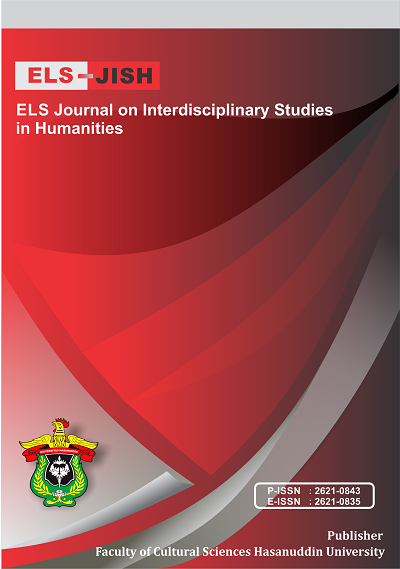Speech Functions and Prepositional Phrases on Shampoo Slogans
DOI:
https://doi.org/10.34050/elsjish.v6i1.26219Keywords:
Advertisemen, Prepositional Phrase, Shampoo Slogan, Speech FunctionAbstract
This article investigated speech functions and prepositional phrases on shampoo slogans. The objectives of this study were to explore the types of speech functions and to examine prepositional phrases on picture shampoo slogans. The data, consisting of 56 shampoo slogans and 11 picture shampoo slogans, were collected from the internet. The method was descriptive qualitative. Results showed that the statement occurred 52 times (92.85%), command, thrice (5.35%), and question once (1.78%). Afterwards, 11 pictures of shampoo slogans were analyzed to categorize speech functions. The findings showed three speech functions, namely a statement, question, and command. The percentages were the statement (81.81%) and command (18.18%). The types of prepositional phrases were analyzed based on the 56 shampoo slogans. The percentages were "for" (29.03%), "of" (24.19%), "to" (17.74%), then "with" (12.90%), "as" (3.22%), "in, about" (3.22%), and "from" (1.61%).
References
Akhtar, S., Sohail, W., & Rizwan, M. (2017). An analysis of preposition (idiomatic phrases, prepositional phrases and zero prepositions) detection errors in the writing of graduate ESL learners of Pakistan. Journal of Literature, Language and Linguistics, 32, 24-42.
Amir P.,M., Sukmawati, Rahman, F.F., & Andini, C. (2023). Symbolic Violence and Woman’s Resistance Reflected in “Legally Blonde” Novel by Amanda Brown. Journal of Positive Psychology & Wellbeing, 7(2), 556–564.
Andini, C., Sosrohadi, S., Fairuz, F., Dalyan, M., Rahman, F. F., & Hasnia, H. (2022). The Study of Japanese Women in the Facial Treatment Advertisement: A Semiotics Perspective of Pierce’s Theory. ELS Journal on Interdisciplinary Studies in Humanities, 5(2), 337-347.
Asrifan, A., Octaberlina, L. R., & Handayani, R. (2021). Semantic analysis on the use of English language slogans. EdArXiv. January, 7.
Batubara, M. H. (2020). An analysis of speech functions on the banking and Daily Need Billboard texts. International Journal of Humanity Studies (IJHS), 4(1), 110-121.
Batubara, M. H., & Nasution, D. S. (2020). The dominant speech functions in cigarette billboard texts. JELTL (Journal of English Language Teaching and Linguistics), 5(2), 177-189.
Cordeiro, C. M. (2018). Using systemic functional linguistics as method in identifying semogenic strategies in intercultural communication: A study of the collocation of “time” and “different” by Swedish managers with international management experiences. Journal of Intercultural Communication Research, 47(3), 207-225.
Doan, V. (2017). Rhetoric in advertising. VNU Journal of Science: Policy and Management Studies, 33(2), 30-35.
Dunn, K., Rumbach, A., & Finch, E. (2022). Language function in the acute phase following non-traumatic subarachnoid haemorrhage: A prospective cohort study. Journal of Communication Disorders, 96, 106192.
Fithri, N. (2021). An analysis of English prepositional errors in Senior High School’s students in Indonesia. JEPAL (Journal of English Pedagogy and Applied Linguistics), 2(1), 66-76.
Huadhom, N., & Trakulkasemsuk, W. (2017). Syntactic analysis of online tourism slogans: frequency, forms and functions. PASAA: Journal of Language Teaching and Learning in Thailand, 53, 182-213.
Isda, I. D. (2019). An analysis of speech function at traditional shopping center in Langsa. JL3T (Journal of Linguistics, Literature and Language Teaching), 5(1), 47-65.
Ismail, D. (2022). How the prepositional phrase arouses ambiguity in three articles published on search. English Journal Literacy Utama, 7(1), 612-621.
Juliarta, I. M. (2021). Prepositional phrase and its translations found in the novel “Budha, a Story of Enlightenment”. EJI (English Journal of Indragiri): Studies in Education, Literature, and Linguistics, 5(1), 28-47.
Mahardika, A. A. A., & Bram, B. (2022). Preposition mistakes in English for specific purposes: The case of Indonesian accounting study program students. Pedagogy: Journal of English Language Teaching, 10(2), 97-110.
Moleong, L. J. (2017). Metodologi penelitian kualitatif. Bandung: Remaja Rosda Karya.
Munawarah. (2018). Speech function in shampoo's advertisement [Master's thesis, Muhammadiyah Sumatera University]. Retrieved from Research repository: http://repository.umsu.ac.id/handle/123456789/3720
Pratiwi, R. S., & Indriani, L. (2021). Corpus Linguistics Study: Analyze The Use Of Prepositions In “Five Feet Apart” Novel By Rachel Lippincott. Journal of Research on Applied Linguistics, Language, and Language Teaching, 4(1), 43-47.
Putri, Y. E., & Syarif, H. (2020). An analysis of prepositional phrase used in thesis at graduate program of Universitas Negeri Padang. In Eighth International Conference on Languages and Arts (ICLA-2019) (pp. 241-247). Atlantis Press.
Putri, D. P. A., Widodo, S., & Chasanah, Z. (2022). The analysis of prepositional phrases found in the Carlo's short story Pinocchio and its application in teaching writing. Scripta: English Department Journal, 9(1), 79-86.
Rahman, F., Sutanto, T. E., & Fitriyati, N. (2021). Web Traffic Anomaly Detection using Stacked Long Short-Term Memory. InPrime: Indonesian Journal of Pure and Applied Mathematics, 3(2), 112-121.
Rahman, F., & Amir, P. (2019). Trends in Reading Literary Fiction in Print and Cyber Media by Undergraduate Students of Hasanuddin University. International Journal of Education and Practice, 7(2), 66-77.
Rizal, I. N., Sumardiyani, L., & Lestari, M. Y. W. (2022). An analysis of phrases in technology brands slogan and its contribution in teaching English grammar. Allure Journal, 2(2), 105-113.
Salvianto, G., & Sulhan, M. (2022). The prepositional phrases and the subordinate clauses in “David Copperfield” by Charles Dickens: a study of syntax. Inference: Journal of English Language Teaching, 5(1), 29-40.
Suci, Z. G., & Rusyan, S. (2022). Language style of beauty product advertising slogan: Sociolinguistics Study. Budapest International Research and Critics Institute-Journal (BIRCI-Journal), 5(2), 1-7.
Wanodyatama, N. P. (2020). The types and functions of prepositions in PS I love you movie by Richard Lagravenese. Lingua Didaktika: Jurnal Bahasa dan Pembelajaran Bahasa, 14(1), 81-86.
Downloads
Published
How to Cite
Issue
Section
License
Copyright (c) 2023 Angelina Kusuma Jelita Mawarni , Barli Bram

This work is licensed under a Creative Commons Attribution-ShareAlike 4.0 International License.






